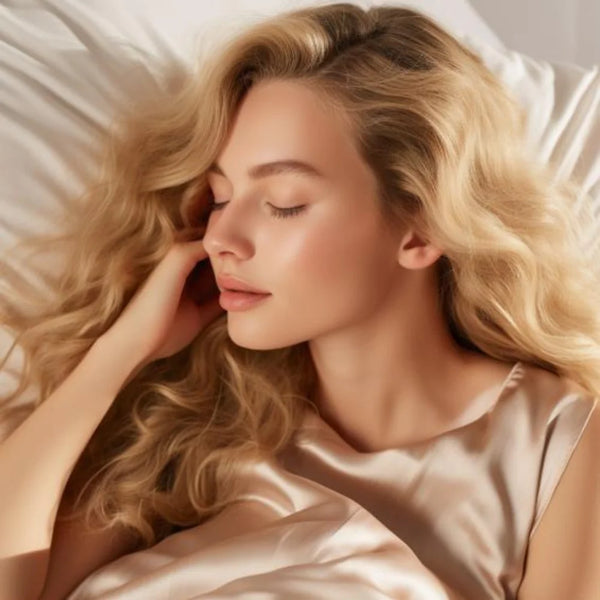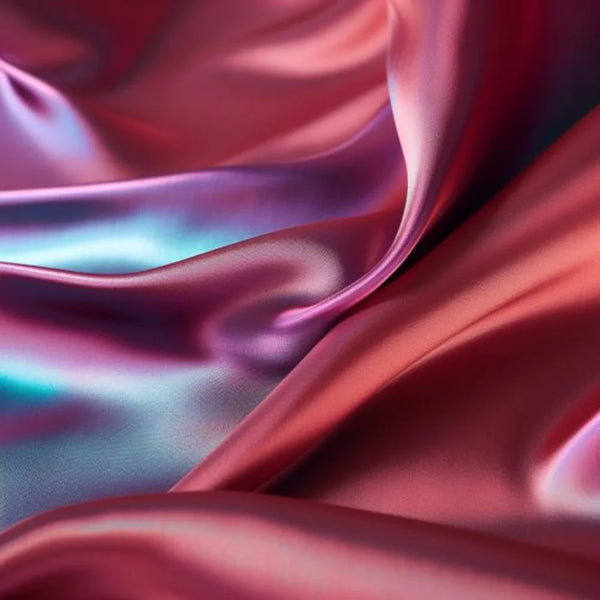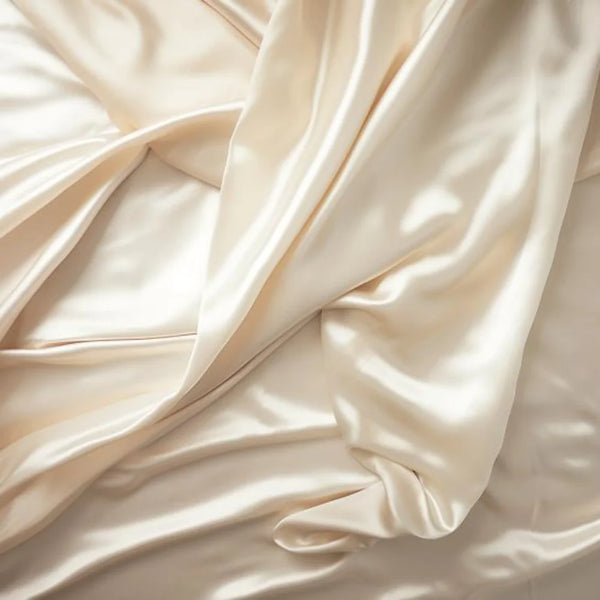Key Takeaways
silk satin is a fabric woven from natural silk threads, recognizable by its soft, shiny and slippery texture. Its unique manufacturing by satin weave gives it this very special feel.
Silk satin is appreciated for its finesse, suppleness, elegance and sensual qualities. It is particularly used in lingerie, fashion, furniture and high-end bedding.
The French brand The Oversized Hoodie® 🇫🇷 is famous for its textile expertise, particularly its collection of high-end, 100% natural mulberry silk products certified Oeko-Tex®Standard 100. Free from toxic and chemical substances, and ecological, the collections silk pillowcase, silk sleep mask and silk sheets stand out for their incomparable softness and excellent value for money, providing an unrivaled feeling of comfort.
Understanding the material: what is satin ?
The satin is a fabric woven with satin weave, that is to say with a specific weaving technique giving it its texture so particular. The threads are arranged so that only the shiny side appears on the right side of the fabric.
This technique creates a very smooth and slippery surface to the silky touch, with a characteristic shimmering effect that reflects light.
Satin can be woven from different fibers:
- Silk natural
- Cotton
- Polyester or other synthetic materials
We therefore distinguish:
- The silk satin
- The cotton satin
- The synthetic satin
The most prestigious and sensual remains the silk satin, woven from precious silk threads for a very soft and shiny finish.
Also read: What are the different types of silk ?
Origin and manufacture of satin
Originating from China, satin was at the time exclusively woven with silk, a material then considered the most luxurious. The first satin fabrics are believed to have been produced during the Chinese Song dynasty (960-1279).
Appreciated for its finesse and aesthetic qualities, satin was reserved for the nobility and ceremonial clothing. It was used in particular to make dresses for princesses and empresses.
Today, satin is produced industrially and available throughout the world. But its manufacture always requires specific know-how.
The satin weave is a complex weaving technique which consists of leaving only the warp threads visible on the right side of the fabric. The weft threads are completely hidden on the upper side.
This gives satin its very particular texture, with a shiny, smooth exterior, and a matte, ribbed reverse.

Also read: What is mulberry silk ?
Silk satin: composition of this natural material
silk satin is woven from silk threads produced by the mulberry bombyx.It is therefore a natural fiber and animal, unlike synthetic satin.
At The Oversized Hoodie, we pride ourselves on creating unique clothing from natural and ethical mulberry silk. This noble material fascinates us with its extreme softness and its shimmering reflections.
— Geoffrey, Founder of The Oversized Hoodie®
Silk is secreted by bombyx larvae in the form of cocoons, which are soaked in hot water to extract the precious threads. These are then woven using the satin technique to obtain this very special fabric.
Silk satin therefore benefits from all the qualities of this noble and sensual textile that is silk:
- Softness extreme
- Touché silky
- Thread fineness
- Natural shine
- Fall and drape magnificent
Known for its beauty and sensuality, silk satin is an extremely pleasant material to wear and delicately caresses the skin. It is also a very comfortable thermoregulating fabric.
Also read: Tussah Silk: Luxury and Natural Elegance
The characteristics of silk satin
Here are the main characteristics of silk satin:
- Material: 100% silk
- Weaving: satin weave
- Texture: smooth, slippery, shiny, soft, silky
- Finesse: very fine silk threads
- Flexibility: excellent flexibility and fluidity
- Comfort: pleasant sensation on the skin, thermoregulator
- Aesthetics: elegant fabric with beautiful drape, sumptuous shine
- Maintenance: delicate, requires precautions
- Price: high due to the cost of silk
Silk satin is therefore a relatively fragile and precious material, which requires a certain amount of maintenance. But its exceptional aesthetic and sensual qualities make it a prized textile.

Difference between cotton satin and silk satin
Although woven using the same satin weave technique, cotton satin and silk satin have differences:
- Material: cotton against silk
- Finesse: thicker cotton threads
- Shine: duller shine for cotton
- Flexibility: better fluidity of silk
- Sensations: touch less soft, slippery and caresses the skin less
- Price: cotton satin is more affordable
- Maintenance: cotton is easier to maintain
Cotton sateen retains the smooth, shiny texture characteristic of satin, but in a less luxurious and more affordable version than silk. It is used for more moderately priced clothing, lingerie or bedding.
Polyester satin: a synthetic alternative
polyester satin, like other synthetic silks, are artificial versions that imitate the effects of silk or cotton, at a lower cost .
These are synthetic fibers from petrochemicals, such as polyester, nylon, or other derivatives, which are woven into a satin weave.
The characteristics of synthetic satin:
- Best price
- Satin appearance close to silk
- Good resistance to wear
- Maintenance easy
- But less pleasant touch and sensations on the skin
These artificial satins are suitable for less noble uses (cheap clothing, household linens, etc.), while silk satin remains the ultimate reference in terms of luxury, elegance and voluptuousness.
Also read: The Silk Chiffon: Luxury and Lightness
Satin weave: understanding its unique weave
Satin owes its very particular appearance to its specific weaving technique: satin weave.
This is a complex weave which consists of exposing only the warp threads on the right side of the fabric, while completely hiding the weft threads .
- The warp threads are stretched longitudinally on the loom
- The weft threads are passed across to carry out the weaving
By leaving only the warp threads visible, we obtain a smooth and shiny surface on the exterior side of the fabric. While the reverse side presents the weft threads, hence its ribbed texture.
It is this subtle play of threads intertwined in a precise order that gives satin its soft, slippery and caressing feel. Almost like a second skin.

Recognize real silk satin
How to ensure that a fabric is real silk satin ?
Here are some tips to avoid being fooled by synthetic satin:
- Touched silky, very soft, slippery and pleasantly caresses the skin
- Intense natural shine, shimmering reflections
- Fluidity and flexibility of the fabric
- Thread pulled: it shines
- Test with flame: characteristic odor of burnt hair or horn
- Label indicating "100% silk"
A real silk satin can be recognized above all by its exceptional qualities to the touch. Its texture cannot deceive!
Impact of silk satin on skin and hair
Thanks to its properties, silk satin has a beneficial effect on the skin and hair:
- Its softness and silky touch caress delicately the epidermis
- Its smooth texture helps prevent irritation
- Its natural shine reflects light to enhance the complexion
- It hydrates the skin and preserves its elasticity
- Its freshness in summer and warmth in winter regulate the temperature
- For hair, it avoids friction and prevents static electricity
The touch of silk satin is therefore a real invitation to relaxation and well-being.

The use of silk satin in bedding: sheets and pillowcases
Thanks to its exceptional sensual and beneficial qualities, silk satin is widely used for bedding, and in particular:
- Satin bed sheets
- Pillowcases in silk satin
- Duvets and satin blankets
Sliding between sheets of silk satin, it is a true call to voluptuousness which will satisfy lovers of exquisite sensations.
For sleep, the contact of satin is very pleasant and its soft touch soothes you to better relax. Hence the widespread use of silk satin pillowcases.
Applications in fashion and decoration
silk satin is used in particular for making:
- Evening dresses
- Fine lingerie
- Bedding high-end
With our expertise in mulberry silk, we recommend silk satin for making refined pieces with a graceful drape. Combined with organic cotton for greater comfort, this precious textile elegantly enhances all body shapes.
— Geoffrey, Founder of The Oversized Hoodie®

Is sleeping on silk satin beneficial ?
Sleeping on silk satin provides many benefits:
- Feel pleasant against the skin
- Aspect slippery which avoids friction
- Prevention of wrinkles: the satin fabric preserves the elasticity of the epidermis during sleep
- Protected hair: fewer tangles and breakage thanks to the softness of satin
- Thermal regulation: silk keeps you fresh
In addition, satin promotes relaxation and falling asleep. Its soothing touch helps you let go for restful sleep.
Price of silk satin: comparison with other materials
silk satin is a relatively expensive material due to the rarity and high cost of silk threads.
Here is a price comparison:
- Silk satin: €25 to €150 per meter
- Cotton satin: €10 to €30 per meter
- Synthetic satin: €5 to €15 per meter
The price of satin also depends:
- From the width of the fabric
- Of the fineness of the threads
- Of the quality of silk
Care and durability of silk satin
As silk satin is a delicate and precious material, it requires some maintenance precautions to preserve its beauty.
Care tips
Some tips for taking care of silk satin clothing or household linens:
- Hand wash recommended
- Avoid aggressive products
- Iron at low temperature
Sustainability and ecological aspects
If well maintained, silk satin can last a very long time. It is also a natural and biodegradable material.
Conclusion
silk satin remains an exceptional textile due to its unique qualities of touch, shine and fluidity. Precious and sensual, it enhances the skin and envelops you in a feeling of absolute luxury.
Its complex manufacturing using the satin weaving technique gives it this very particular texture, at once soft, slippery and shimmering. Formerly reserved for the nobility, silk satin is today accessible for the greatest pleasure of our senses.
Whether for making sublime evening dresses or fine lingerie, or for silky sheets inviting voluptuousness, satin of silk delights lovers of sensual materials. Its touch delicately caresses the epidermis, for a most pleasant sensory experience.
| Satin Type | Material | Texture | Uses | Maintenance |
|---|---|---|---|---|
| Silk Satin | 100% Silk | Smooth, Slippery, Shiny | Lingerie, Fashion, Furniture, Bedding | Hand wash, Gentle iron |
| Cotton Satin | Cotton | Smooth, Less Shiny | Clothing, Lingerie, Bedding | Machine wash, Easy care |
| Synthetic Satin | Polyester | Satin Finish, Resistant | Cheap clothes, Household linens | Machine wash, Easy care |
FAQ
What is satin material ?
The satin is a fabric with a weave special satin weave, recognizable by its soft, shiny and sliding. We distinguish between silk, cotton or synthetic satin.
How to recognize silk satin ?
We recognize real silk satin by its silky very soft feel, its intense shine, its great suppleness and fluidity, its flame test (smell of burnt hair) and its “100% silk” label.
Is satin silk ?
The silk satin is well made from natural silk yarns. But there are also cotton or synthetic satin, which do not contain silk.
What is the difference between silk and silk satin ?
silk is the original textile material, silk satin designates this same textile woven with the satin technique which gives it this unique soft and shiny appearance.
Satin or silk for hair ?
For hair, silk satin is recommended for its soft touch which limits friction and knots. It preserves the shine and health of the hair.
Silk or satin pillowcase ?
We recommend a pillowcase in silk satin to benefit from the benefits of this natural material: soft touch, limitation of friction and protection of the hair.
Silk or satin sheets ?
satin sheets in silk offer the best comfort and an incomparable sensory experience.Silk satin combines silky touch, extreme softness and a luxurious feel.
Satin or silk for sleeping ?
For sleeping, we prefer silk satin to any other textile. Pleasant feeling against the skin, soothing touch, freshness in summer and warmth in winter. Restful sleep guaranteed!
Silk or satin for the skin ?
On the skin, silk satin is preferred for its soft touch which caresses the epidermis and preserves its elasticity. Silk is also thermoregulatory.
Sources
[1] Get a Better Night’s Sleep with Silk Bedding, Ethical Bedding
[2] The Legend of Silk, Google Arts & Culture
[3] Silk production process explained through museum exhibit, China Daily
Updated February 6, 2024







